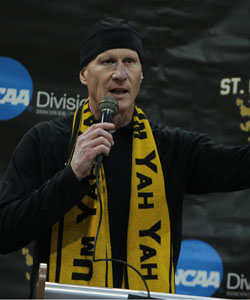USTFCCCA News & Notes
St. Olaf Coach Phil Lundin Just Wants to “Chop Wood, Carry Water”
NEW ORLEANS—St. Olaf head men’s cross country and track coach Phil Lundin finds himself in the enviable position of managing expectations and goals after the Oles won a shocking national title last fall and were rewarded with their first-ever No. 1 ranking in the coaches poll this week. He has decades of experience at the highest level, as he took over the University of Minnesota head coaching job from the legendary Roy Griak in 1996 after nine years as Griak’s assistant. (In fact, when we spoke on the phone Friday, Lundin had just returned from lunch with Griak)The apex of his tenure at Minnesota was 2003, when the Gophers won the Big Ten outdoor meet and Lundin was named USTFCCCA Division I coach of the year.
Since Lundin’s workplace shifted the 45 miles from Minneapolis to Northfield in 2008, St. Olaf has skyrocketed to prominence in Division III. After only qualifying for cross country nationals twice between 1979 and 2007, the Oles have made it to NCAAs under Lundin five out of the last six years. Last year’s 84-86 NCAA championship squeaker over North Central (Ill.) is tied for the smallest margin of victory in DIII history, and six of the seven runners that won that title return this fall.
Lundin also exudes a Gregg Popovich-ian drollness, agreeing to my interview request with a warning that there was “Not much to say” – clearly not the case judging by our conversation below. He once told a Minnesota running website that he and assistant coach Dave “Griff” Griffith “are probably the worst motivators in the world” and qualified his pre-meet approach with “Being Norwegian, I was a little bit dour in my prognostications.” The tone in which he proclaims “I can’t believe it, I’m stunned” and dismisses a reporter’s strategy question with “we’re not smart enough to come up with a strategy” after the Olaf men won nationals is well worth a minute of your time.
Below, Coach Lundin and I tackle particle physics, cooking, our favorite fabrics, and the vagaries of baseball sabermetrics (okay, not really, but it’s still a fun conversation).

Courtesy: St. Olaf
DY: Last year, nobody would have pegged St. Olaf as the favorite to win nationals—you guys were ranked 15th in the preseason and still only 3rd the week before NCAAs. Now you’re ranked No. 1 and have a target on your back. How do you deal with that shift as a coach?
PL: I think of the saying, “chop wood, carry water.” You have to go about your business whether or not you’ve won a national championship. It doesn’t make any difference in how our guys do there runs and get the work done at practice every day. We definitely turned over the apple cart on the big dogs of Division III last year, and people are going to pay more attention to us this year.
Athletes will get more sensitive. What would have been just a little owie in their minds last year becomes paramount this year because we’re trying to defend a national title.
Last year was a dream; all the stars were in alignment for that to happen. This year, it’s a cliché, but again, “chop wood, carry water.” You know, that’s what’s really nice about Division III. There’s none of the hype, none of the B.S. that there is at other levels. It’s not like we’re getting greeted with a banquet everywhere we go, and it’s certainly not that I’m getting some enormous bonus in my paycheck. This is just part of the experience of their liberal arts education.
DY: That was going to be my next question. Having coached at Minnesota for so long, what are the biggest differences you’ve observed between DI and DIII?
PL: Well, a big difference is that the kids here dabble in way more activities. When you’re on a scholarship and competing and training on a Big 10 level, there simply isn’t time. The athletes I coached at Minnesota didn’t really have time to pursue many interests outside of studying and running. Here, sometimes to my chagrin, kids might miss practice time to pursue their other passions.
The guys here who are really passionate about running manage to get the work done, even with everything else that they’re serious about. It’s quite remarkable.
We do have room for the guy who’s trying really hard to break five minutes in the mile, even though he doesn’t have anything to do with nationals or scoring points at the conference meet. It’s rewarding to see that guy—it’s the sport for its own sake.
DY: St. Olaf has had a pretty meteoric rise as a program in the six years since you got there. How do you get a team to improve so much, so quickly?
PL: I think that with some serious recruiting, we had good old fashioned luck with some very talented runners that we were able to develop into national quality, and then other athletes started to take notice. Then, things go from there.
I don’t know—how do things like this happen? My coaching partner Griff and I don’t do anything special. We do pretty traditional training with a few twists. We’re always willing to change things for an individual; nothing’s set in stone. If there’s anything, that’s it.
Who the hell knows with these things?
